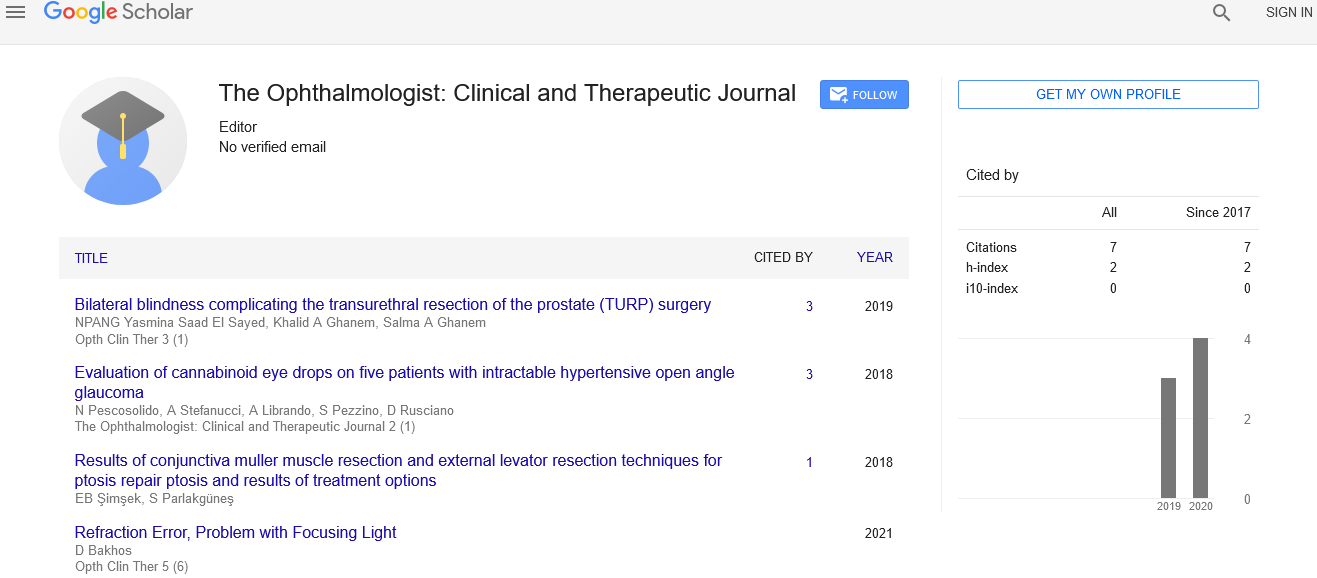Epithelial cytokeratin 3 expression in cultured human keratocytes: Implications for mesenchymal-epithelial transition
Received: 16-Oct-2023, Manuscript No. PULOCTJ-23-6805; Editor assigned: 18-Oct-2023, Pre QC No. PULOCTJ-23-6805 (PQ); Reviewed: 02-Nov-2023 QC No. PULOCTJ-23-6805; Revised: 17-Jan-2024, Manuscript No. PULOCTJ-23-6805 (R); Published: 24-Jan-2024
Citation: Ketrina R. Epithelial cytokeratin 3 expression in cultured human keratocytes: Implications for mesenchymal-epithelial transition. Opth Clin Ther. 2024;8(1):1.
This open-access article is distributed under the terms of the Creative Commons Attribution Non-Commercial License (CC BY-NC) (http://creativecommons.org/licenses/by-nc/4.0/), which permits reuse, distribution and reproduction of the article, provided that the original work is properly cited and the reuse is restricted to noncommercial purposes. For commercial reuse, contact reprints@pulsus.com
Abstract
The study investigates the expression of epithelial cytokeratin 3 in cultured human keratocytes derived from the limbus and cornea, shedding light on potential mesenchymal-epithelial transition processes. Immunocytochemistry and molecular analysis were employed to assess the presence of cytokeratin 3 in these cells. Our findings suggest the possibility of a mesenchymalepithelial transition in keratocytes, highlighting the intricate cellular dynamics within the ocular surface.
Keywords
Epithelial cytokeratin 3; Keratocytes; Limbus; Cornea; Mesenchymal-epithelial transition
Introduction
The cornea is a transparent, avascular tissue that plays a pivotal role in vision by refracting light onto the retina. It is comprised of multiple layers, with the outermost being the corneal epithelium and the underlying stroma containing keratocytes. Keratocytes, the quiescent resident cells of the corneal stroma, maintain the extracellular matrix and contribute to corneal transparency and shape. Recent studies have shown that keratocytes possess remarkable plasticity and can transition to different phenotypes, including myofibroblasts and possibly epithelial-like cells, under certain stimuli.
Cytokeratins are intermediate filament proteins primarily found in epithelial cells, contributing to cellular structure and function. Cytokeratin 3 (CK3), a specific cytokeratin isoform, is a hallmark of corneal epithelial cells. However, recent investigations have shown the presence of CK3 in non-epithelial cells, challenging traditional views of its exclusivity to epithelial lineages. This study explores the expression of CK3 in cultured human keratocytes derived from the limbus and cornea, aiming to shed light on potential mesenchymal-epithelial transition processes within these cells.
Description
Cultured human keratocytes were obtained from limbal and corneal tissue samples. Immunocytochemistry was performed to detect CK3 expression using specific antibodies. Molecular analysis involved quantitative Real-Time Polymerase Chain Reaction (qRT-PCR) to quantify CK3 mRNA levels in cultured keratocytes.
Immunocytochemical analysis revealed notable CK3 expression in the cultured human keratocytes derived from both limbal and corneal samples. Additionally, qRT-PCR demonstrated a significant increase in CK3 mRNA levels compared to baseline, further supporting the presence of CK3 in keratocytes.
Cultured human keratocytes were obtained from limbal and corneal tissue samples. Immunocytochemistry was performed to detect CK3 expression using specific antibodies. Molecular analysis involved quantitative Real-Time Polymerase Chain Reaction (qRT-PCR) to quantify CK3 mRNA levels in cultured keratocytes.
Immunocytochemical analysis revealed notable CK3 expression in the cultured human keratocytes derived from both limbal and corneal samples. Additionally, qRT-PCR demonstrated a significant increase in CK3 mRNA levels compared to baseline, further supporting the presence of CK3 in keratocytes. These findings suggest that keratocytes may have a previously unrecognized capacity to express epithelial markers, highlighting their potential for undergoing Mesenchymal-Epithelial Transition (MET) under specific conditions.
The implications of CK3 expression in keratocytes could be substantial for understanding corneal wound healing and regeneration. The plasticity of keratocytes allows them to respond dynamically to injuries or stressors, and their ability to express CK3 might enhance their functional contributions during repair processes. This plasticity could be particularly beneficial in pathological conditions, where keratocyte activation and transition into myofibroblasts are commonly observed, potentially leading to fibrosis and impaired corneal transparency.
Further investigations into the signaling pathways and environmental factors that promote CK3 expression in keratocytes will be essential to elucidate the mechanisms underlying their plasticity. Additionally, exploring the functional consequences of CK3 expression on keratocyte behavior, such as proliferation, migration, and extracellular matrix remodeling, could provide valuable insights into their role in corneal health and disease.
Conclusion
In conclusion, the expression of CK3 in keratocytes indicates a complex interplay between mesenchymal and epithelial characteristics in these cells, suggesting that they may play a more versatile role in corneal biology than previously understood. These findings pave the way for future research into harnessing the regenerative potential of keratocytes for therapeutic applications, particularly in corneal diseases and injuries. Understanding these mechanisms may ultimately lead to improved strategies for enhancing corneal repair and maintaining vision.





